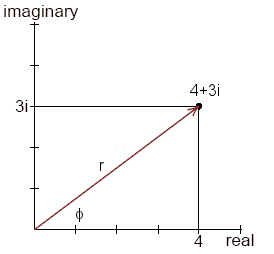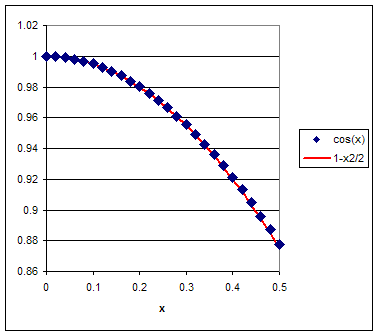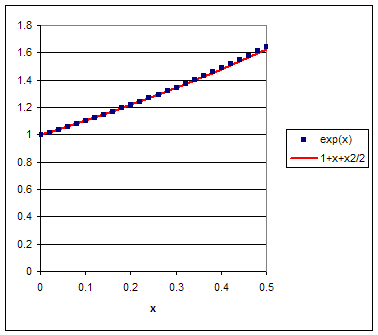

In this laboratory you will work with complex numbers. You will plot complex numbers in the complex plane, convert complex numbers from rectangular to polar form and from polar to rectangular form and add, subtract, multiply and divide complex numbers.
Study the sections below and complete tasks 1-5. Answer all questions highlighted in blue in full sentences. Open a Microsoft Word document to keep a log of your answers.
√(9) = √(9*(1)) = √9 * √(1)= 3 * i
All numbers with a factor of i are imaginary.

Once we start plotting complex numbers on x and y axes, we will find that any complex number can be expressed in the exponential form
x + iy = r cos(φ) + i r sin(φ) = r exp(iφ).
Here exp(iφ) is defined as exp(iφ)= cos(φ) + i sin(φ). When using the exponential notation, we give the angle in radians.
One way to describe the point 4 + 3i in the complex plane is to give its x and y coordinates (x = 4, y = 3i). An equally good description, is to give the distance r from the origin to the point, and the angle φ that r makes with the x or real axis. From the Pythagorean theorem we have
r2 = x2 + y2 = 16 + 9 = 25,
r = 5.
The tangent of the angle φ is the opposite side y divided by the adjacent side x, tanφ = y/x = 3/4 = 0.75, φ = 36.9°. Thus the point 4 + 3i is located at a distance r = 5 from the origin at an angle φ = 36.9°. It is traditional to use the letter z to describe a complex number. Thus if a complex number (z) has a real part (x) and an imaginary part (iy), we can write,
z = x + iy = r cos(φ) + i r sin(φ),
z = r(cos(φ) + isin(φ)).
Task 2:
Let z = 6 + 8i.
Use millimeter paper, set up a coordinate system with a real and an imaginary axis, and plot the point z. Label the point.
z = r(cos(φ) + isin(φ)). Use a ruler and a protractor and find r and φ. What are your values using this method?
Find r and φ algebraically. What are your values using this method?
Let z = 6 - 8i.
Plot this point z on the same graph as the previous point. Label the point.
What are r and φ for this point?
Let r = 4.24, φ = 225o.
z = x + iy. What are the values for x and y?
Let us study the function cos(φ) + i sin(φ) in
more detail. Let us first look at the derivative of cos(φ) + i sin(φ).
Since
dcos(φ)/dφ = sin(φ)
and dsin(φ)/dφ = cos(φ)
we get
d(cos(φ)+ i sin(φ))/dφ = sin(φ) + i cos(φ)
Since (1) = i2, this can be written
d(cos(φ) + i sin(φ))/dφ = i2sin(φ) + i cos(φ)
= i (cos(φ) + i sin(φ))
To express this result more formally, let us write f(φ) = cos(φ) + i sin(φ). Then
df(φ)/dφ = i f(φ).
To within a constant (i), the function f(φ) is equal to
its own derivative. What function that you are
already familiar with, behaves this way? The exponential
function!
Recall that d(exp(ax))/dx = a exp(ax).
Thus if we replace x by φ and a by i , we get
d(exp(iφ))/dφ = i exp(iφ).
We see that the function cos(φ) + i sin(φ) and the function exp(iφ) obey the same rule for differentiation. When two functions have the same derivatives, does that mean that they are the same functions? It does, if we show that both functions start off with the same value for small values of φ. Then as we increase φ, if both functions have the same derivative or slope, i.e. if they CHANGE in the same way, they must continue to be the same function for all values of φ.
We can verify this by doing a series expansion.
For small values of x the function exp(x) can be written as
exp(x) ~ 1 + x + x2/2,
and the functions cos(x) and sin(x) can be written as
cos(x) ~ 1 - x2/2, sin(x) ~ x.
This is shown in the graphs below.



Therefore we can verify for small values of f that
exp(iφ) ~ 1 + iφ + (iφ)2/2 = 1 + iφ - φ2/2 = (1 - φ2/2) + iφ = cos(φ) + i sin(φ).
So the function cos(φ) + i sin(φ) and the function exp(iφ) obey the same rule for differentiation and both functions start off with the same value for small values of φ. Therefore we have for all values of φ
exp(iφ) = cos(φ) + i sin(φ).
If we replace φ by -φ we get
exp(-iφ) = cos(-φ) + i sin(-φ).
Since cos(-φ) = cos(φ) sin(-φ) = sin(φ), this gives
exp(-iφ) = cos(φ) - i sin(φ)
Adding exp(iφ) = cos(φ) + i sin(φ) and exp(-iφ) = cos(φ) - i sin(φ) we find
cos(φ) = (exp(iφ) + exp(-iφ))/2
and subtracting we find
sin(φ) = (exp(iφ) - exp(-iφ))/(2i).
This gives us a complete prescription
of how to go back and forth between cos(φ), sin(φ),
and exp(iφ).
Finally returning to our complex function we write
z = x + iy = r cos(φ) + i r sin(φ) = r exp(iφ)).
We have z = r exp(iφ) as the other way of expressing a complex number,
where r is the distance from the origin and φ the angle
the coordinate vector r makes with the x or real axis.
Let z = 5 exp(i3.665)
The complex conjugate of a complex number is defined as the number we get by replacing all factors of i by i in the formula for the number. We generally denote the complex conjugate by placing an asterisk after the number. For example, if z = x + iy, then z* = x iy. If we start with z = r exp(iφ), then z* = r exp(-iφ).
Let z = 6 exp(i 5.585)
Adding, subtracting, multiplying and dividing complex numbers
Let z1 = x1 + iy1, z2 = x2 + iy2.
The main reason for defining a complex conjugate is
that the product of a complex number z with its
complex conjugate z* is always a real positive
number, equal to the square of the distance r of the
complex point from the origin. For our two
examples above, we have
z*z = (x iy)(x + iy) = x2 ixy + iyx i2y2 = x2 + y2 = r2
and
z*z = r exp(iφ) r exp(-iφ) = r2.
We call z*z the square of the absolute value of the complex number and denote it by z*z = |z|2.
Use your log to prepare a report.
Describe, in your own words, what complex numbers are.
Give an algebraic expression which has no real solution.
Enter your answers to the questions (in blue) from parts 1-5.
It is generally accepted that the five most famous numbers
in mathematics are 1, 0, e, i, and π.
Construct an algebraic equations using as many of the five numbers as
possible without the use of other numbers.
Are you able to use all five numbers in an equation?
Submit your equation that uses the most of these numbers.
Submit your word document and your plot to your lab instructor.